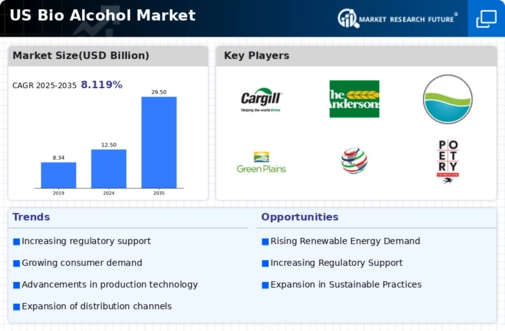Government Policies and Incentives
The US bio alcohol market is significantly influenced by government policies and incentives aimed at promoting renewable energy sources. The Renewable Fuel Standard (RFS) mandates a certain volume of renewable fuels, including biofuels, to be blended into the transportation fuel supply. This regulatory framework encourages investment in bio alcohol production facilities and technologies. In 2022, the US Environmental Protection Agency (EPA) proposed an increase in the volume requirements for renewable fuels, which could lead to a projected growth rate of 5% annually in the bio alcohol sector. Such policies not only support domestic production but also enhance energy security, making the US bio alcohol market more attractive to investors and producers alike.
Consumer Demand for Renewable Energy
There is a growing consumer demand for renewable energy solutions, which is driving the US bio alcohol market. As awareness of climate change and environmental issues increases, consumers are seeking sustainable alternatives to fossil fuels. According to a 2023 survey, approximately 70% of American consumers expressed a preference for products made from renewable resources, including bio alcohols. This shift in consumer behavior is prompting manufacturers to incorporate bio alcohols into their products, thereby expanding the market. Additionally, the automotive industry is increasingly adopting biofuels, with several major car manufacturers committing to using bio alcohol blends in their vehicles. This trend suggests a robust future for the US bio alcohol market as it aligns with consumer preferences for sustainability.
Environmental Regulations and Standards
The US bio alcohol market is shaped by stringent environmental regulations and standards aimed at reducing greenhouse gas emissions. The Clean Air Act and other federal and state regulations require a reduction in carbon emissions from transportation fuels, which bio alcohols can help achieve. In 2023, the EPA reported that biofuels, including bio alcohols, could reduce greenhouse gas emissions by up to 50% compared to conventional fuels. This regulatory environment encourages the adoption of bio alcohols as a viable alternative, fostering growth in the market. Furthermore, states like California have implemented their own stringent standards, further driving demand for bio alcohols in the transportation sector. Such regulations not only promote environmental sustainability but also enhance the competitiveness of the US bio alcohol market.
Technological Innovations in Production
Technological innovations play a crucial role in enhancing the efficiency and cost-effectiveness of bio alcohol production, thereby benefiting the US bio alcohol market. Advances in fermentation technology, enzyme development, and feedstock processing have led to higher yields and lower production costs. For instance, the introduction of genetically modified microorganisms has improved fermentation processes, allowing for the conversion of a wider range of feedstocks into bio alcohols. As of 2025, the production capacity of bio alcohols in the US is expected to reach 15 billion gallons, driven by these technological advancements. This increase in production capacity not only meets the rising demand but also positions the US bio alcohol market as a leader in the global biofuel landscape.
Investment in Infrastructure Development
Investment in infrastructure development is a key driver for the US bio alcohol market. The establishment of production facilities, distribution networks, and blending stations is essential for the growth of bio alcohols. In recent years, federal and state governments have allocated significant funding to support infrastructure projects that facilitate the production and distribution of biofuels. For example, the US Department of Agriculture (USDA) announced a $200 million investment in biofuel infrastructure in 2024, aimed at enhancing the supply chain for bio alcohols. This investment is expected to create jobs and stimulate economic growth while ensuring that bio alcohols are readily available to consumers. As infrastructure improves, the US bio alcohol market is likely to experience increased accessibility and market penetration.
















